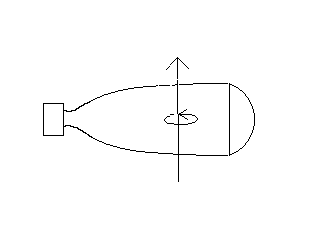Propulsion
Our vehicle will have four thrusters: one main thruster which provides
approximately 500 N of force and three maneuvering thrusters which control the
three directions of motions (discussed in Orientation section below), and each
of these provides about 250 N of force. One lateral thruster positioned at the
tail of the vessel is resposible for controlling yaw, while two forward
thrusters are capable of controlling both roll and pitch. When the main
thruster and the two forward thrusters operate in unison, a maximum speed of
1.8 knots can be achieved.
Orientation
There are three primary directional quantities which are important in
characterizing the motion of a submersible vehicle, and thrusters must be able
to control these. These quatitities are roll, pitch, and yaw, and their
meanings are as follows:
Roll describes the rotation of a vehicle about an axis parallel to
the direction of motion and running through the center of mass of the vehicle.

Pitch describes a vehicle's change in vertical inclination.

Yaw desicribes a vehicle's change in horizontal inclination.

Drag
Thrust requirements for a vehicle are dictated primarily by drag
connsiderations. The drag force on a submersible is dependent upon its
velocity, so a vehicle which can produce a fixed amount of thrust will have a
limit to its velocity. Drag force on an object in a fluid can be calculated
with the following formula:
FD = (1/2)r(CD)A(V2)
where r is the density of the fluid, CD is the coefficient of drag, A is the
cross-sectional area of the object perpindicular to the direction of motion,
and V is the velocity at which the object is traveling.
The coefficient of drag varies for different objects. For a perfect
sphere, this coefficient is 0.5, but for objects with a lesser diameter to
length ratio this value is less.
Our vehicle has diameter to length ratio of about 0.4. This means the
coefficient of drag for the vehicle must be less than 0.5, but to leave room
for error, we can calculate drag while using CD = 0.5. The vehicle has a
radius of 1.25 meters, so the cross sectional area is (3.14*1.252) m2. We
can find the drag for on our vehicle while traveling at a speed of v in knots
(1 knot = 0.494 m/s). The density of water is 1000 kg/m3, so putting these
values into the equation yields:
FD = (v2)(0.5)(1000)(3.14*1.252)(0.5)(0.4942) = (v2) * 300 N
The sum thrust provided by all thruster must be greater than the force of drag.
Using 1000 N as maximum thrust, this equation yields a maximum speed of about
1.8 knots. If only the main thruster is used, the maximum speed is 1.3 knots.


